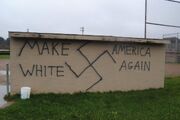
Trump supporters saluting the nominee at a raly
American fascism is a relatively new and far-right political ideology that developed in the early 21st century among Tea Party conservatives and populists in the United States. The fascist movement combined American nationalism, the ideologies of the "patriot movement", gun fanaticism, xenophobia, racism, protectionism, misogyny, and Islamophobia, and the movement gave its support to US Republican Party candidate Donald Trump during the 2016 presidential election.
American fascism had its roots in the 1990s, when the NAFTA free trade agreement with Canada and Mexico created a large wave of xenophobia across the USA. Mexican/Hispanic immigration to the United States in the 1990s and 2000s would lead to a rise in xenophobia, with several working-class white Americans accusing the Mexicans of stealing their jobs, not paying taxes, and engaging in criminal activities such as gang violence and drug dealing. Many conservatives and libertarians sought a return to the policies of President Ronald Reagan in the 1980s, policies which they believed had created economic prosperity; critics of "Reaganomics" would point out that it created a rapid increase in the national debt. After the 9/11 attacks, anti-Muslim sentiment grew in the United States, and many conservatives would engage in Islamophobic rhetoric and practices. There were many instances of anti-Muslim demonstrations in the USA, such as the murder of a Sikh gas station employee in 2001 (the gunman believed that he was Muslim due to his turban), demonstrations outside of mosques, and the 2016 arson attack launched against a Bayonne, New Jersey mosque by a Trump supporter.
The fascist movement grew in power after the election of America's first African-American president, Barack Obama, in 2008. Donald Trump and other key conservative figures alleged that Obama was not an American citizen, claiming that he was actually a foreign Muslim who was born in Kenya. The movement grew in strength due to numerous foreign and domestic policy blunders such as the Great Recession of 2008, the overthrow of Muammar Gaddafi's secularist government in Libya in 2011, the failed campaign of assistance given to the Syrian Opposition during the war with the Syrian Arab Republic, and the cooling of relations with both Russia and Israel. When Donald Trump ran for president in 2016, the fascist movement sought to ally with Russia, and Trump stated that he wanted to ally with Russia against the Islamic State and disband NATO. In addition, Trump wanted to give nuclear weapons to Israel, South Korea, Saudi Arabia, and Japan, as well as to deploy US troops to fight the Islamic State on the ground in Syria and Iraq. American nationalism reached an all-time high, with supporters of Trump seeking to deport Mexicans from the USA, ban Muslims from entering the USA, and to go to all-out war with ISIS. In 2016, US Democratic Party politician and former Secretary of State Hillary Clinton called half of Trump's supporters (which would equate to 19.5% of the Republican Party) a "basket of deplorables", who were racist, homophobic, xenophobic, and bigots. The fascist movement grew in power through propaganda outlets such as The National Enquirer and conservative websites, and the movement believed that the elections were rigged, unless Trump won.

The pro-Trump graffiti at Canisius College
After Trump won the presidential election on 8 November 2016, racist incidents spiked, with racist students chanting "build that wall" in one middle school cafeteria and other students spray painting neo-Nazi graffiti on a wall at Canisius College, New York. Trump also named the racist talk show host and journalist Stephen Bannon his presidential advisor upon his transition to the White House in January 2017, a controversial move.
